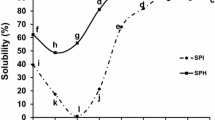Abstract
The Japanese traditional fermented soybean or “natto”, a cheap and nutrient-rich food, is very popular in Japan. The low-phytate (LP) soybeans exhibit higher mineral bioavailability; however, their use in preparing natto has not been reported. Therefore, in this study, characteristics and quality of natto prepared using LP soybean were investigated. The findings revealed a better color, lower stickiness, and lower hardness and taste of LP natto with lower phytate and higher inorganic phosphorus (Pi) concentrations than those in the normal-phytate (NP) natto. However, the Ca, Mg, and K concentrations were not significantly different between LP and NP natto, whereas the protein level in NP natto was slightly higher than that in LP natto. These findings indicate that the lower phytate content in LP natto than that in NP natto, could facilitate a higher bioavailability of P and other minerals. Moreover, the improved color and lower stickiness, in addition to lower hardness and taste of LP natto, imparted through improved manufacturing process could increase its acceptability overseas, thereby increasing its commercial value. These improved qualities of LP natto could contribute to improving human health as well as increasing sustainable food and nutrient security.



Similar content being viewed by others
References
Dimidi E, Cox SR, Rossi M, Whelan K (2019) Fermented foods: definitions and characteristics, impact on the gut microbiota and effects on gastrointestinal health and disease. Nutrients 11:1806. https://doi.org/10.3390/nu11081806
Leejeerajumnean A (2003) Thua nao: alkali fermented soybean from Bacillus subtilis. Silpakorn Univ Int J 3:277–292. https://doi.org/10.1016/j.jef.2015.08.004
Murakami K, Yamanaka N, Ohnishi K, Fukayama M, Yoshino M (2012) Inhibition of angiotensin I converting enzyme by subtilisin NAT (nattokinase) in natto, a Japanese traditional fermented food. Food Funct 3:674–678. https://doi.org/10.1039/c2fo10245e
Kaneki M, Hedges SJ, Hosoi T, Fujiwara S, Lyons A, Ishida N, Nakagawa M, Takechi M, Sano Y, Mizuno Y (2001) Japanese fermented soybean food as the major determinant of the large geographic difference in circulating levels of vitamin K2: possible implications for hip-fracture risk. Nutrition 17:315–321. https://doi.org/10.1016/s0899-9007(00)00554-2
Wei Q, Wolf-Hall C, Chang K (2001) Natto characteristics as affected by steaming time, Bacillus strain, and fermentation time. J Food Sci 66:167–173. https://doi.org/10.1111/j.1365-2621.2001.tb15601.x
Kubo Y, Nakagawa R (2018) Development of low sticky texture natto “MAMENOKA”. Synthesiology 11:1–12. https://doi.org/10.5571/synth.11.1_1
Raboy V (2020) Low phytic acid crops: observations based on four decades of research. Plants 9:140. https://doi.org/10.3390/plants9020140
Hirabayashi M, Matsui T, Yano H (1998) Fermentation of soybean meal with Aspergillus usamii improves zinc availability in rats. Biol Trace Elem Res 61:227–234. https://doi.org/10.1007/BF02784033
Egounlety M, Aworh O (2003) Effect of soaking, dehulling, cooking and fermentation with Rhizopus oligosporus on the oligosaccharides, trypsin inhibitor, phytic acid and tannins of soybean (Glycine max Merr.), cowpea (Vigna unguiculata L. Walp) and groundbean (Macrotyloma geocarpa Harms). J Food Eng 56:249–254. https://doi.org/10.1016/S0260-8774(02)00262-5
Dong Q, Saneoka H (2020) Physiological characteristics, phytase activity, and mineral bioavailability of a low-phytate soybean line during germination. Plant Foods Hum Nutr 75:383–389. https://doi.org/10.1007/s11130-020-00827-x
Kumar A, Kumar V, Krishnan V, Hada A, Marathe A, Parameswaran C, Jolly M, Sachdev A (2019) Seed targeted RNAi-mediated silencing of GmMIPS1 limits phytate accumulation and improves mineral bioavailability in soybean. Sci Rep 9:7744. https://doi.org/10.1038/s41598-019-44255-7
Wilcox JR, Premachandra GS, Young KA, Raboy V (2000) Isolation of high seed inorganic P, low-phytate soybean mutants. Crop Sci 40:1601–1605. https://doi.org/10.2135/cropsci2000.4061601x
Chen PS, Toribara TY, Warner H (1956) Microdetermination of phosphorus. Anal Chem 28:1756–1758. https://doi.org/10.1021/ac60119a033
Raboy V, Dickinson DB (1987) The timing and rate of phytic acid accumulation in developing soybean seeds. Plant Physiol 85:841–844. https://doi.org/10.1104/pp.85.3.841
Mariotti F, Tomé D, Mirand PP (2008) Converting nitrogen into protein—beyond 6.25 and Jones’ factors. Crit Rev Food Sci Nutr 48:177–184. https://doi.org/10.1021/10.1080/10408390701279749
Hill BE, Sutton AL, Richert BT (2009) Effects of low-phytic acid corn, low-phytic acid soybean meal, and phytase on nutrient digestibility and excretion in growing pigs. J Anim Sci 87:1518–1527. https://doi.org/10.2527/jas.2008-1219
Kobayashi K, Shimojo S, Watanabe S (2016) Contribution of a fermentation process using Bacillus subtilis (natto) to high polyamine contents of natto, a traditional Japanese fermented soy food. Food Sci Technol Res 22:153–157. https://doi.org/10.3136/fstr.22.153
Acknowledgements
This study was funded by the Japan Society for the Promotion of Science KAKENHI to Saneoka H. Financial support was also received from the China Scholarship Council to Mr. Qin Dong. The authors would like to thank Mrs. Hosokawa T., Masaoka K., Yorizane H., Natsume Y., Futamura Y., Okamoto T. and Ms. Tasukawa E., Kakizawa H., Kumagai M., Ogawa M. for contribution to breeding low phytate lines.
Author information
Authors and Affiliations
Corresponding author
Ethics declarations
Conflict of Interest
The authors declare no conflict of interest.
Rights and permissions
About this article
Cite this article
Qin, D., Hara, Y., Raboy, V. et al. Characteristics and Quality of Japanese Traditional Fermented Soybean (Natto) from a Low-phytate Line. Plant Foods Hum Nutr 75, 651–655 (2020). https://doi.org/10.1007/s11130-020-00865-5
Received:
Revised:
Accepted:
Published:
Issue Date:
DOI: https://doi.org/10.1007/s11130-020-00865-5




